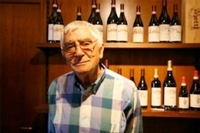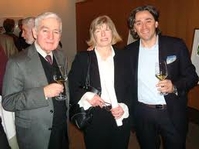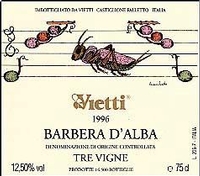Producer of the Year: Vietti
Vietti is my wine producer of the year. For many years, this winery has been a leader in Piedmont’s Langhe region, for both its Barolo wines and its Barberas. It seemed fitting to name Vietti my producer of the year in 2010, with the passing this year of Alfredo Currado, the wine genius responsible for establishing Vietti as a great winery. Alfredo died on April 30th at the age of 78, after battling Parkinson’s disease for 12 years.
 A trained oenologist, Currado took over as winemaker in 1960 after the death of his father-in-law, Mario Vietti . He immediately began innovations. In 1961 Vietti was the first winery in the region to make a single-vineyard Barolo, from the Rocche vineyard in Currado’s home village, Castiglione Falletto. Currado also made a single-vineyard Barbaresco Masseria that year. Currado’s reasoning was that there are some vineyards so special that they should not be blended with the grapes from other vineyards—an idea well-established in Burgundy, but novel in traditional Piedmont at that time. Rocche remained Currado’s favorite Barolo vineyard his entire life.
A trained oenologist, Currado took over as winemaker in 1960 after the death of his father-in-law, Mario Vietti . He immediately began innovations. In 1961 Vietti was the first winery in the region to make a single-vineyard Barolo, from the Rocche vineyard in Currado’s home village, Castiglione Falletto. Currado also made a single-vineyard Barbaresco Masseria that year. Currado’s reasoning was that there are some vineyards so special that they should not be blended with the grapes from other vineyards—an idea well-established in Burgundy, but novel in traditional Piedmont at that time. Rocche remained Currado’s favorite Barolo vineyard his entire life.
In 1967, Alfredo Currado revived the white variety Arneis from obscurity and near-extinction (a few farmers were blending it with other varieties). Now, of course, many producers in Piedmont are making an Arneis wine.
For me, one of Alfredo Currado’s most brilliant moves was establishing his home vineyard, Scarrone, as a source of great Barbera. Up until the mid-70s, Nebbiolo (the wine grape of Barolo) had been growing in Scarrone. Currado decided that the quicker-ripening Barbera would be more successful in Scarrone than the late-ripening Nebbiolo, and ripped up the vineyards to plant Barbera. His neighbors thought Currado was crazy. Who would rip out Nebbiolo to plant Barbera, thought to be a far less-noble variety—which sold as a wine for one-fourth or one-fifth that of Barolo? Time proved Currado to be right; his Barbera Scarrone has become one of the great wines from this variety, especially Vietti’s “Vigna Vecchia” bottling, made from the oldest vines in Scarrone.
 Today, Alfredo’s 41-year-old son, Luca Currado, continues making some of the best Barolos and Barberas around. Vietti has other wines, including a very good Barbaresco and Dolcetto, but Barolo and Barbera are its stars. For me, Vietti’s two great Barolos are its single-vineyard Rocche and the Villero Riserva, produced in superior vintages. Vietti’s 2006 Barolo Rocche is the current vintage; it’s a powerful long-lived wine that needs another eight to ten years to mature. The 2006 Vietti Villero Riserva has not yet been released; only small quantities of the Villero are made.
Today, Alfredo’s 41-year-old son, Luca Currado, continues making some of the best Barolos and Barberas around. Vietti has other wines, including a very good Barbaresco and Dolcetto, but Barolo and Barbera are its stars. For me, Vietti’s two great Barolos are its single-vineyard Rocche and the Villero Riserva, produced in superior vintages. Vietti’s 2006 Barolo Rocche is the current vintage; it’s a powerful long-lived wine that needs another eight to ten years to mature. The 2006 Vietti Villero Riserva has not yet been released; only small quantities of the Villero are made.
 Probably because Alfredo and Luca Currado have always given Barbera the respect it deserves, not treating it as a second-class citizen, Vietti is regarded as one of the elite—if not the best—producers of Barbera. Vietti’s two under $20 Barberas, Barbera d’Alba Tre Vigne and Barbera d’Asti Tre Vigne, always sell out rather quickly. They are made with just a touch of oak aging. I am currently enjoying the 2007 Vietti Barbera d’Asti Tre Vigne; 2008 is the current vintage.
Probably because Alfredo and Luca Currado have always given Barbera the respect it deserves, not treating it as a second-class citizen, Vietti is regarded as one of the elite—if not the best—producers of Barbera. Vietti’s two under $20 Barberas, Barbera d’Alba Tre Vigne and Barbera d’Asti Tre Vigne, always sell out rather quickly. They are made with just a touch of oak aging. I am currently enjoying the 2007 Vietti Barbera d’Asti Tre Vigne; 2008 is the current vintage.
For a truly sublime Barbera experience, try one of Vietti’s single-vineyard Barberas: 2006 Barbera d’Asti La Crena (my favorite) is currently retailing for about $45; 2006 or 2007 Barbera d’Alba Scarrone about $40 to $45; and the exquisite 2006 or 2007 Barbera d’Alba Scarrone “Vigna Vecchia” about $80 to $85. Only small quantities of the Vigna Vecchia are made.
Vietti is the only winery that owns vineyards in all eleven Barolo-producing communes. Alfredo Currado was a firm believer in owning and controlling his own vineyards. Fortunately for all of us Piedmontese wine lovers, Luca Currado is following in Alfredo’s footsteps admirably, making Vietti a name to look for when choosing a great Barolo or Barbera.
Wine of the Year: Planeta 2009 Carricante
My wine of the year is brand new: Planeta’s 2009 Carricante, a white wine from the vineyards on Mount Etna, in Sicily. In many ways, this could be Italy’s most important new wine of the year.
 Mount Etna has gone through a wine revival in the past twenty years. The very steep slopes and extremely cool climate had discouraged winemaking here in the past. But a few pioneer winemakers gave it a go in the 1980s, and the resulting wines proved to be excellent. The terroir is perfect for making exciting, cool-climate wines: minerally, lava-rich soil, steep slopes, and very cool temperatures. One of the first winemakers to tackle Mt. Etna, Benanti, still produces the state-of-art Carricante, his “Pietramarina.”
Mount Etna has gone through a wine revival in the past twenty years. The very steep slopes and extremely cool climate had discouraged winemaking here in the past. But a few pioneer winemakers gave it a go in the 1980s, and the resulting wines proved to be excellent. The terroir is perfect for making exciting, cool-climate wines: minerally, lava-rich soil, steep slopes, and very cool temperatures. One of the first winemakers to tackle Mt. Etna, Benanti, still produces the state-of-art Carricante, his “Pietramarina.”
Benanti is a small producer, and does not have the kind of distribution that will make Carricante or any of the other Mt. Etna wines a household word among consumers. In fact, up until now, all of the handful of wine producers on Mt. Etna were tiny. But Planeta is a major player in Sicilian wines, arguably the most well-known and most highly distributed of current wine producers on the island. Planeta has four winemaking facilities throughout the southern part of the island; its Mt.Etna winery, which should be completed in 2011, will be its first venture into the cool northeastern part of Sicily. Planeta and a few other large Sicilian producers who have started making wines on Mt. Etna will be able to give this region the recognition it deserves.
Planeta’s first wine made from Mt. Etna, the 2009 Carricante (about $40 retail), made from the Sciara Nuova vineyard, is a beauty: very lively, brimming with minerally flavors, with a lemony zip, it really wakes up the palate. It’s a natural pairing for seafood or with a seafood pasta dish.
The Sciara Nuova vineyard is 2, 854 feet above sea level. At this height only a few white varieties, like Carricante, can ripen. It is aged in stainless steel only, and the wine does not go through malolactic fermentation, to keep it fresh and lively.
Winemaker Alessio Planeta, although very happy with his first attempt with Carricante (only 547 cases made), revealed that the vines are still young, only six years old, and that the wine will get even better as the vines age. Seeing how much I liked his 2009 Carricante, I can’t wait for future vintages! Planeta has also planted some Reisling in the Sciara Nuova vineyard, and plans to add about ten percent of it to the Carricante wine in the future.
About 800 feet down the slope, red varieties, such as Nerello Mascalese, are growing. This will be winemaker Alessio Planeta’s next challenge, he revealed. We both agreed that Mt. Etna has become Sicily’s most exciting new region, one that put Sicily on the map as a major player in fine wines.
5
